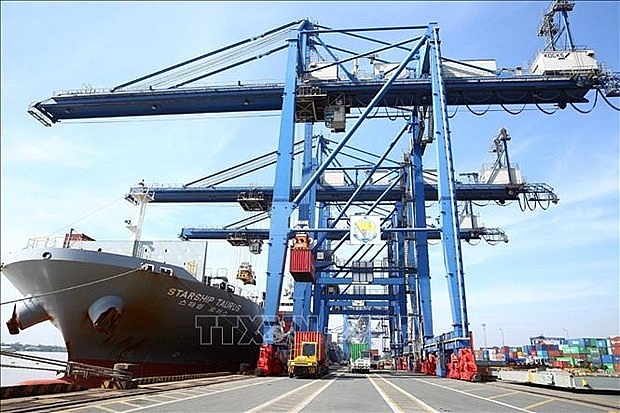Vietnamese shipping lines grapple with Chinese regulations
 |
| Goods loading at Cat Lai port in Ho Chi Minh City. (Photo: VNA), illustration photo |
Dang Hong Truong, deputy general director of Vietnamese ocean shipper VOSCO, is still feeling a headache with cargo ships stranded in container ports in China. Normally, it takes about five days for clearance of 50,000DWT vessels at Chinese ports, but restrictions now mean it often takes much longer.
When any shipping lines arrive at Chinese ports, all crew have their temperatures checked. If a crew is infected with COVID-19, a line will have to wait 14-21 days in anchorage. At some ports, crews can get a rapid test or carry out a PCR test before getting anchored. Shipping lines have to return home if an infection is found, and then a blockade is applied at a berth.
“The number of vessels does not increase, while the prolonged stranded period will result in a lack of vessels amid rising trade volume, thus increasing freight costs, leasing fees and commodity prices,” Truong explained. “Many Vietnamese shipping firms shifted to leasing vessels instead of operating them on the Chinese routes.”
Similarly, Saigon Newport Corporation is also struggling. Deputy general director Nguyen Dai Hai said that port operators normally pay for COVID-19 testing and disinfectant spraying. However, in some Chinese areas, vessel operators have to cover the payment. China does not currently accept vaccine passports or testing results from Vietnam.
The strict rules have increased freight costs and additional fees, and even a loss of dozens of thousands of US dollars due to returns if an infection emerges. A 50,000DWT vessel has a leasing fee of $20,000 a day, and if the trip is delayed 10 days due to one infection, a shipping firm may lose about $200,000, depending on the type of contract.
In addition to extra costs, shipping firms have to bear contract fines due to the slow delivery of commodities and a reduction in operational frequency.
Despite being aware of the risks and losses, shipping firms keep running on the Chinese routes because it is the biggest export-import market in the world. Bilateral trade between Vietnam and China still recorded strong growth in 2021, despite the harsh disruption. China continues to be Vietnam’s largest trading partner and second-largest export market, while Vietnam was China’s largest trading partner in ASEAN and its sixth-largest trading partner globally.
Instead, shippers look to mitigate negative impacts by keeping crews unchanged on the Chinese routes.
“The risk is that some people can test positive for COVID-19 after several days on board, although they earlier tested negative. This remains a big headache,” Hai lamented. “We always have masks and use disinfection test kits as well as temperature and anti-virus drugs on board.”
Minh Tien from Bien Dong Shipping Co., Ltd. added that the same crew could be on board for 8-12 months. Tien’s company limits contact with crews on the Chinese routes. “These staff on board for such a long time may be psychologically affected, thus affecting the entire safety of the ship. In case of force majeure, which would force shipping lines to change their crew, they have to cover COVID-19 testing fees,” he said.
Tien proposed that authorised agencies work out policies on supporting businesses in procedures for crews if they are on board for too long. As ruled in 2006’s Maritime Labour Convention, the maximum period of working on board is 12 months.
China’s continuing strict pandemic policy has left hundreds of cargo ships stranded in ports, and not only Vietnamese ones. Maersk, the world’s second-largest shipping company, has suggested that the lockdowns are severely impacting truck services, and transport costs would witness a rise at an unexpected level. It is said that 90 per cent of the world’s goods are carried via the sea.
Due to strict rules, many ports in China have been heavily congested, such as Yantian in Guangdong province. It was blockaded in early March and, when restrictions were removed from March 20, data from maritime intelligence company Windward showed a soar of over 50 per cent in the number of port calls. In April, the average transportation time from a port to Yantian among vessels rose 98 per cent on-year, and it took container vessels from Vietnam an extra 45 per cent of time in the sea before being able to call at a Chinese port.
Many Vietnamese shipping firms said that in the past, they could carry out unloading when making a call at ports in Hong Kong or Shanghai, but now it takes at least three days for port calls.
China is home to half of the world’s 20 largest container ports by yearly throughput, and experts say that if the delays continue for an unexpected period, other ports may not be capable of filling the void, with some factories finding it challenging to keep momentum going due to the high curbs felt over the past year and more.
What the stars mean:
★ Poor ★ ★ Promising ★★★ Good ★★★★ Very good ★★★★★ Exceptional
Latest News
More News
- Global partnerships key to Vietnam’s IFC development (December 26, 2025 | 16:18)
- Vingroup pulls out of bid to invest in North-South high-speed railway (December 26, 2025 | 11:42)
- Strengthening supply chains through trade promotions and customs reform (December 24, 2025 | 14:00)
- PM orders investment model for North–South high-speed rail (December 22, 2025 | 17:43)
- LS Eco Energy to invest in Vietnam rare earth sector (December 22, 2025 | 17:31)
- Government moves to establish International Financial Centre (December 21, 2025 | 21:00)
- Vietnam's IFC to target global investment flows (December 21, 2025 | 18:00)
- Two national hospitals expand capacity with new facilities (December 20, 2025 | 09:00)
- Ha Tinh breaks ground on major Vingroup industrial and energy projects (December 19, 2025 | 18:24)
- EVN launches major power infrastructure projects nationwide (December 19, 2025 | 18:17)

 Tag:
Tag:















 Mobile Version
Mobile Version